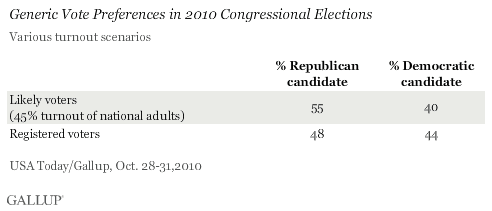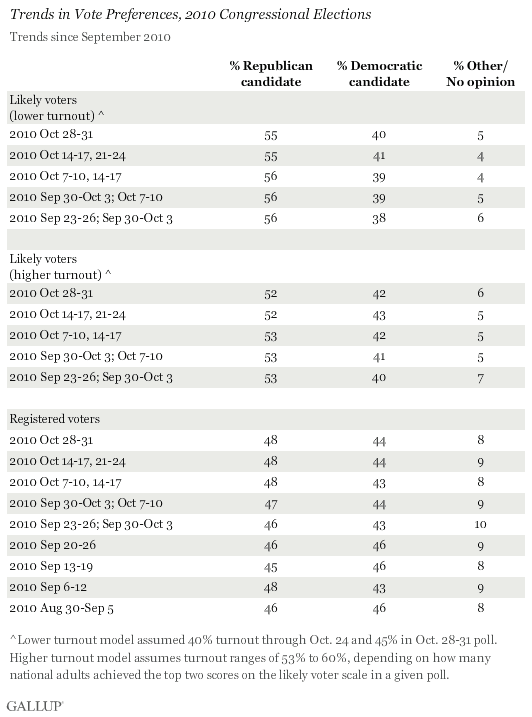PRINCETON, NJ -- The final USA Today/Gallup measure of Americans' voting intentions for Congress shows Republicans continuing to hold a substantial lead over Democrats among likely voters, a lead large enough to suggest that regardless of turnout, the Republicans will win more than the 40 seats needed to give them the majority in the U.S. House.
The results are from Gallup's Oct. 28-31 survey of 1,539 likely voters. It finds 52% to 55% of likely voters preferring the Republican candidate and 40% to 42% for the Democratic candidate on the national generic ballot -- depending on turnout assumptions. Gallup's analysis of several indicators of voter turnout from the weekend poll suggests turnout will be slightly higher than in recent years, at 45%. This would give the Republicans a 55% to 40% lead on the generic ballot, with 5% undecided.

Republicans' 15-percentage-point lead among likely voters contrasts with their 4-point lead, 48% to 44%, among registered voters, highlighting the importance of higher GOP turnout to the election outcome. This wide difference between the GOP's margin among registered voters and its margin among likely voters is similar to the 2002 midterms, in which Democrats led by 5 points among all registered voters in Gallup's final pre-election poll, while Republicans led by 6 points among likely voters -- an 11-point gain.
These final estimates of the vote among registered and likely voters are consistent with Gallup polling since Sept. 23. Republicans have led by an average of 4 points among registered voters and by 16 points among a low-turnout estimate of likely voters since that time. Thus, while voter preferences could change in the final two days, perhaps resulting from Democrats' final push to motivate their base to turn out, voter preferences appear to be quite settled in this final post-Labor Day phase of the campaign.
A Republican Majority Very Likely
Gallup models the number of seats a party will control based on that party's share of the national two-party vote for the House of Representatives, using historical voting data in midterm elections from 1946 to 2006. The model takes into account the majority party in Congress entering the elections.
Gallup's historical model suggests that a party needs at least a two-point advantage in the national House vote to win a majority of the 435 seats. The Republicans' current likely voter margin suggests that this scenario is highly probable, making the question of interest this election not whether the GOP will win the majority, but by how much. Taking Gallup's final survey's margin of error into account, the historical model predicts that the Republicans could gain anywhere from 60 seats on up, with gains well beyond that possible.
It should be noted, however, that this year's 15-point gap in favor of the Republican candidates among likely voters is unprecedented in Gallup polling and could result in the largest Republican margin in House voting in several generations. This means that seat projections have moved into uncharted territory, in which past relationships between the national two-party vote and the number of seats won may not be maintained.
Additionally, efforts by state legislatures in recent years have attempted to insulate incumbent members of Congress from strong partisan tides such as are in force this year. Congressional district lines have been drawn to make them safe for specific parties, which may reduce the impact of national trends on election outcomes.
In the early part of the 20th century, it was not unusual for an election to bring about a change in party control of 50 House seats or more. In recent decades, the partisan shifts have been more modest, with the Republicans' 54-seat gain in 1994 a rare exception.
Turnout Holds the Key
To the extent Tuesday does bring about a strong Republican wave, it will be to a significant degree the result of turnout. Republicans have a slender 4-point advantage in the preferences of registered voters, which expands to 15 points among likely voters. Republicans usually turn out at higher rates than Democrats, so the margin's expansion is not unusual, but its size this year is. In general, Republicans' advantage in the vote is strongest in an average turnout scenario, while higher turnout scenarios bring more Democrats into the likely voter pool and increase the Democratic share of the vote.
Republicans' turnout advantage is highlighted by two key questions used as part of Gallup's likely voter model. One asks Americans how much thought they have given to the upcoming elections; the other asks those who say they plan to vote how certain they are about voting.
The Oct. 28-31 poll finds that nationally, 75% of Republicans and independents who lean Republican are "absolutely certain" they will vote in the 2010 midterms, compared with 68% of Democrats. While these figures are not the only indicator of relative turnout strength -- this is just one question in Gallup's seven-item likely voter model -- the record-high seven-point gap between the parties is strongly indicative of a relative surge in GOP turnout.

Similarly, 68% of Republicans and Republican leaners say they have given "quite a lot of" or "some" thought to the elections. This compares with 54% of Democrats giving the same amount of thought to the elections, resulting in a 14-point difference between the parties. That gap is greater than any Gallup has seen since and including the 1994 midterms.

Overall, Gallup's final likely voter pool consists of 35% of Americans identifying as Republicans, 32% as Democrats, and 32% as independents.
Vote by Key Demographic Groups
The structure of the vote among subgroups of the American population follows typical patterns.
Republicans do best among the following groups: men, whites, those living in the South and West, higher-income households, those who are married, and those who attend church frequently, with Democrats generally doing better among the demographic counterparts in each instance. (For full results by subgroup, please see page 2.)
There is virtually no difference in the percentage of Republican and Democratic likely voters supporting their own party's candidate. Ninety-two percent of Democrats are voting for the Democratic candidate in their district, and 96% of Republican likely voters are voting for the Republican candidate. Independents tilt toward the Republican candidate by a sizable 59% to 31% margin. The margin for Republican congressional candidates among independents is much greater among likely voters than among registered voters, suggesting independents voting Republican are significantly more likely to turn out than are those voting Democratic.
Key Indicators on Election Eve
The final pre-election survey continues to show that most key indicators assessing the political climate are not favorable toward the incumbent party.
President Obama's job approval rating among national adults is at 45% in this final pre-election survey. This is higher than the 38% job approval rating George W. Bush had just before the 2006 midterm elections, lower than Bush's 63% approval before the 2002 midterms and Bill Clinton's 66% approval before the 1998 midterms, and about the same as the 46% Clinton had before the 1994 midterms. Presidents whose approval ratings have been below 50% have suffered an average loss of 36 House seats in midterm elections since 1946.
Twenty-one percent of Americans approve of the job Congress is doing, and 22% of Americans say they are satisfied with the way things are going in the country right now. Both of these measures are essentially tied with or lower than those before any previous midterm elections since Gallup began measuring them systematically.

Learn more about Gallup's likely voter models for the 2010 midterm congressional elections.
Results for this USA Today/Gallup poll are based on telephone interviews with 2,240 national adults, aged 18 and older, conducted Oct. 28-31, 2010. For results based on the total sample of national adults, one can say with 95% confidence that the maximum margin of sampling error is ±2 percentage points.
For results based on the sample of 2,027 registered voters, the maximum margin of sampling error is ±3 percentage points.
Results for likely voters are based on the subsample of 1,539 survey respondents deemed most likely to vote in the November 2010 midterm elections, according to a series of questions measuring current voting intentions and past voting behavior. For results based on the total sample of likely voters, one can say with 95% confidence that the maximum margin of sampling error is ±4 percentage points. Based on past voting history in United States midterm elections and current interest in the election, turnout is assumed to be 45% of the voting-age population.
Interviews are conducted with respondents on landline telephones (for respondents with a landline telephone) and cellular phones (for respondents who are cell phone only). Each sample includes a minimum quota of 150 cell-phone-only respondents and 850 landline respondents, with additional minimum quotas among landline respondents for gender within region. Landline respondents are chosen at random within each household on the basis of which member had the most recent birthday.
Samples are weighted by gender, age, race, education, region, and phone lines. Demographic weighting targets are based on the March 2009 Current Population Survey figures for the aged 18 and older non-institutionalized population living in continental U.S. telephone households. All reported margins of sampling error include the computed design effects for weighting and sample design.
In addition to sampling error, question wording and practical difficulties in conducting surveys can introduce error or bias into the findings of public opinion polls.
View methodology, full question results, and trend data.
For more details on Gallup's polling methodology, visit www.gallup.com.

